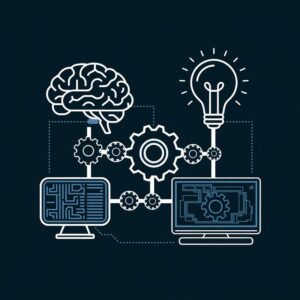Top 10 Real-World Applications of Machine Learning in 2025
Machine learning has evolved from an emerging technology to a transformative force across industries. In 2025, ML continues to unlock new chances, not only automating routine tasks but also enabling decisions with greater accuracy and speed. From healthcare to transportation, ML is powering smarter decisions, reducing human effort, and enabling automation at an unusual scale. 
And here are the top 10 real-world applications of ML in 2025
Personalized Healthcare and Early Diagnosis
The most promising application of ML in 2025 is in healthcare. ML algorithms are helping doctors to diagnose diseases like cancer and diabetes. Analyze patient records, lab records, and genetic data to provide personalized treatment.
- ML models trained on radiology images can now detect abnormalities more accurately than the human eye.
- Chatbots and virtual assistants powered by ML now handle preliminary consultations
Finance Fraud Detection and Risk Management.
ML is being heavily used in banking and finance to detect fraud, assess credit risk, and personalize services. By inspecting past transaction patterns, it flags suspicious activity in real-time, preventing major financial loss.
- Loan approvals are now quicker and more accurate with ML-based credit scoring.
- Investment platforms use ML for algorithmic trading, predicting stock movements with high accuracy.
Autonomous Vehicles: Safer Roads Through AI
Meanwhile, the transportation industry continues to be revolutionized by ML. Self-driving cars use machine learning to process data from sensors, cameras, and GPS to make driving decisions in real-time.
- ML systems learn from millions of road conditions and driving patterns.
- Advanced Driver Assistance Systems (ADAS) reduce accidents by offering automated braking and lane assistance.
- Logistics companies use ML for route optimization, saving time and fuel
Predictive Maintenance in Manufacturing
Meanwhile, the manufacturing sector is experiencing greater efficiency thanks to predictive maintenance powered by ML.
- This reduces downtime and saves millions in repair costs
- Supply chain bottlenecks are avoided using ML forecasts and planning tools.
Smart Learning in Education
ML is driving the personalized design learning experience.
- AI tutors provide instant help and recommend learning resources.
- Predictive analytics help identify students at risk of falling behind.
- Institutes can predict student dropout risks and intervene early.
ML is not just helping students succeed academically, but also supporting educators to managing classrooms successfully.
Enhanced Cybersecurity
Cybersecurity in 2025 relies heavily on ML to detect, analyze, and respond to threats.
- ML models powered by cybersecurity tools can detect unusual patterns of behavior across networks and user activity.
- They adapt quickly to new attack strategies that traditional firewalls may miss.
- User behaviour analytics help organizations spot insider threats early.
Notably, companies like Google and Microsoft integrate ML into their cloud platforms to offer real-time threat detection and automatic response systems.
Climate Change Monitoring and Environmental Management
Simultaneously, ML is playing an essential role in climate change research and environment sustainability.
- Satellites and Sensors collect massive datasets on temperature, deforestation, and pollution.
- ML analysis this data to model climate trends and forecast natural disasters.
- Smart agriculture systems use ML to optimize water use and boost crop yields sustainably.
Thus, machine learning is empowering efforts to save the planet.
Entertainment and Content Creation
The entertainment industry is witnessing creativity with ML.
- Streaming platforms use ML to recommend content that aligns wth viewers’ tastes.
- Music and Video creation tools now generate AI- Assisted content songs, visuals and even movie script.
- Social media platforms curate feeds using ML to increase engagment and reduce misinformation.
Hence, entertainment is becoming more engaging, interactive, and personalized.
E-commerce and Retail Personalized
In the same vein, e-commerce platforms use ML to offer highly personalized shopping experiences.
- Recommendation engines suggest products based on browsing history, preferences, and buying behavior.
- Dynamic pricing adjusts costs based on demand, competition, and customer profiles.
- Virtual fitting rooms and visual search are enhancing customer interaction.
Language Processing: Chatbots and Voice Assistants
Lastly, ML is revolutionizing how we interact with machines through Natural Language Processing (NLP). From voice assistants like Alexa and Siri to chatbots on websites, ML enables these systems to understand and respond in human-like ways.
Over time, these tools are becoming more content-rich and capable of handling complex conversations, making customer service more efficient and accessible around the clock.
Final Thoughts
To summarize, ML in 2025 is not just a concept; it’s a force driving real-world solutions. From healthcare to agriculture, and from cybersecurity to education, ML continues to evolve and integrate into our everyday lives.
After all, the ultimate goal of machine learning is not just automation but argumentation, helping humans make better decisions and live better lives.

